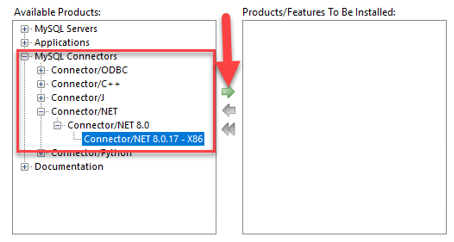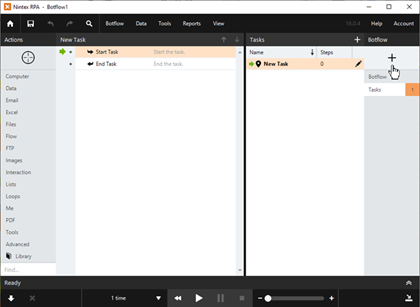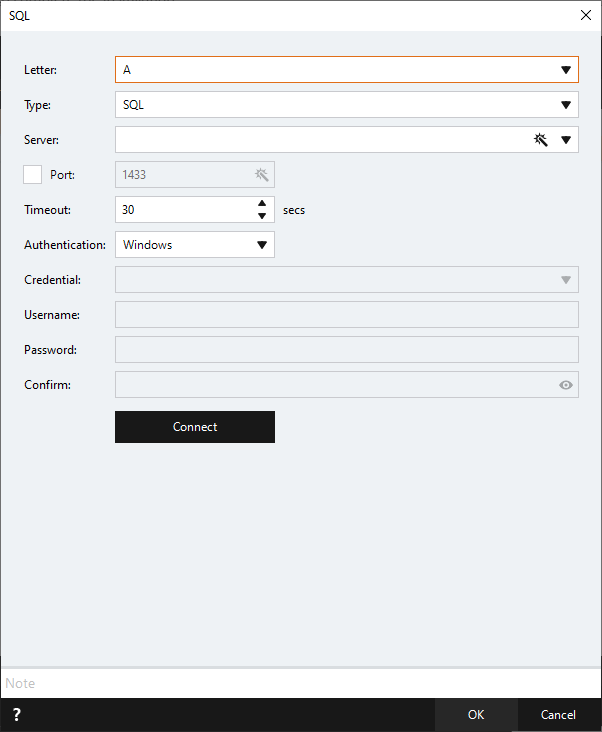SQL
Use SQL to import database table records from a SQL Server database or MySQL database into a data file. The data file is used in a botflow A file that stores the actions and variables designed to automate tasks. to access the imported records.
The first time you try to use Data - SQL or SQL to connect to a MySQL database you will be prompted to install the MySQL Connector if it is not already installed.
- Navigate to the connector download.
- Select Product Version 8.0.17 and select the 393.4M download.
- When running the installation, select Custom.
- Select Connector/NET 8.0.17 - x86 from the Available Products list and move it to the Products/Features To Be Installed list.
- Click Next and Execute to complete the installation.
- Navigate to C:\Program Files (x86)\MySQL\Connector NET 8.0\Assemblies\v4.5.2.
- Select and copy Rence.SshNet.dll.
- Navigate to C:\Program Files (x86)\Nintex\RPA and paste Renci.SshNet.dll.

Create an SQL server connection
To create an SQL server connection:
- Click Add Item (
 ) on the Botflow Pane.
) on the Botflow Pane. - Click SQL.
- Select a connection letter from the Letter drop-down list, or accept the default.
- Select the SQL type from the Type drop-down:
- SQL - Select to use with a SQL database.
- MySQL - Select to use with a MySQL database. Requires that MySQL be installed.
- In the Server field, do one of the following:
- Enter the required server name.
- Click the Expression Builder to build the server name using variable or other token values.
- For SQL, click the down button to retrieve a list of available SQL Servers.
- Check the Port box to enter a port number or accept the default (1433).
- Enter a timeout value in the Timeout field or use the up and down buttons to incrementally change the value by one second.
- For SQL, select the authenticate type from the Authentication drop-down:
- Windows - Uses your Windows log in credentials.
- SQL - Uses the credentials set for the SQL server connection.
Credential: Select the credential required for the SQL server connection.
- Username: Displays the username stored in the credential that is required for the SQL server connection.
- Password: Displays the password stored in the credential required for the SQL server connection.
- Confirm: Re-enter the password, if required, for the SQL server connection.
- Credential: Select the credential required for the MySQL server connection.
- Username: Displays the username required for the MySQL server connection.
- Password: Displays the password required for the MySQL server connection.
- Confirm: Re-enter the password, if required, for the MySQL server connection.
- Click Connect to connect to the SQL database server or MySQL database server and retrieve a list of available databases.
- Select an available database from the Database drop-down list.
- Optionally, enter a Note describing the SQL connection.
- Click OK to save the SQL connection for use in the botflow.

The SQL window displays.

For MySQL: Uses the credentials set for the MySQL server connection.
- Navigate to the SQL server connection on the Botflow Pane.
- Right-click the SQL connection.
- Use the Context Menu to:
- Add an SQL server connection - displays the SQL screen to create another SQL server connection.
- Edit the SQL server connection - displays the SQL screen with the existing SQL server connection information for editing.
- Delete the SQL server connection - removes the SQL server connection information from the Botflow.
- Duplicate the SQL server connection - creates a copy of the SQL server connection information with the next available connection letter.
The Context Menu displays.
SQL connection window field and button descriptions
| Field or button | Description |
|---|---|
| Letter |
|
| Type |
|
| Server |
|
| Port |
|
| Timeout |
|
| Authentication |
For SQL, select the authenticate type from the Authentication drop-down:
For MySQL: Uses the credentials set for the MySQL server connection. |
| Credential | Select the credential required for the SQL or MySQL server connection. |
| Username | Enter the username associated with the selected SQL server or MySQL server. |
| Password | Enter the password associated with the selected SQL server or MySQL server. |
| Confirm | Confirm the password associated with the selected SQL server or MySQL server. |
| Connect |
Click Connect to connect to the SQL database server or MySQL database server and retrieve a list of available databases. |
| Database |
Select an available database from the Database drop-down list. |
| Note |
Optionally, add a note to an action to document any special instructions or functionality. |
| OK/Cancel | Click OK to save the SQL connection or click Cancel to discard the SQL connection or any changes. |